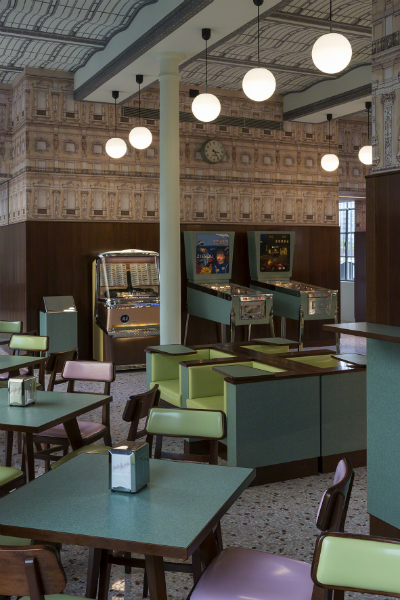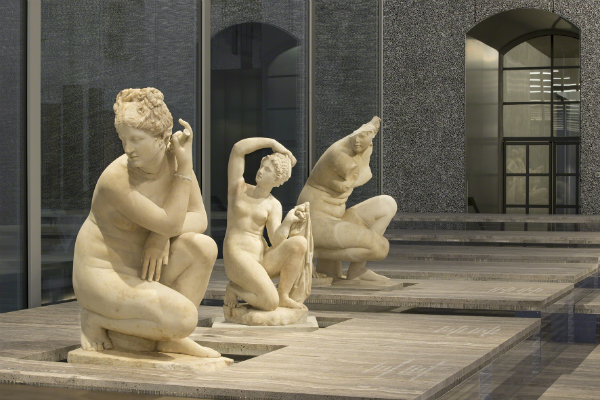Art & Exhibitions
Rem Koolhaas Designed Prada Foundation Opens in Milan on Eve of Venice Biennale
The top of the art and fashion worlds celebrated the opening in Milan.
The top of the art and fashion worlds celebrated the opening in Milan.
Lorena Muñoz-Alonso

Last weekend, the new Fondazione Prada in Milan was presented to a selected group of VIPs, ahead of its opening to the public on May 9, which coincides with the launch of the Venice Biennale (see Take a Look Inside Miuccia Prada and Patrizio Bertelli’s New Fondazione Prada).
The creme of the crop of the art and fashion worlds met in the evening to celebrate a party in honor of the new foundation, including Dasha Zhukova, Jeff Koons, Hans Ulrich Obrist, and Anna dello Russo, among others.
The vast 19,000 square-meter venue—an old distillery dating from 1910 and located in southern Milan—has been designed by OMA, the studio of renowned architect Rem Koolhaas, who has designed a number of Prada stores in the last 15 years, including flagships in New York and Los Angeles (see OMA Designs New Fondazione Prada Building).
The project involved the renovation of seven existing buildings at a complex in Largo Isarco, as well as the design of three new ones: a cinema, a gallery, and a tower, still under construction. One of the buildings, known as the “Haunted House,” has been covered in 24-karat gold leaf, adding a touch of decadence to an otherwise austere and sleek design.

Bar Luce, designed by film director Wes Anderson, at the new Fondazione Prada
Photo: Courtesy Fondazione Prada
The Fondazione also features Bar Luce, a café designed by film director Wes Anderson (see Wes Anderson Commissions a Surrealist Theme Park). The retro design, complete with wallpaper on the ceiling and walls, Formica furniture, and wooden paneling, references the typical Milanese cafes of the 1950s and 60s.
Fondazione Prada was established in 1993 and the new Milan venue gives the foundation a permanent exhibition space, after years of hosting activities in spaces in Milan and Venice, and a number international outings.
The launch of the new premises is accompanied by an ambitious and varied program of exhibitions. “Serial Classic” explores seriality and copy in classical art through a collection of 70 ancient sculptures and reproductions, which have been loaned by a number of institutions including the Louvre, the British Museum, and the Vatican Museums. The ultra-modern exhibition design, which sees the antique sculptures displayed over a stage of stone slabs, comes courtesy of OMA.

Installation shot of the exhibiton “Serial Classic”
Photo: Courtesy Fondazione Prada
“An Introduction,” curated by Germano Celant in collaboration with Miuccia Prada, focuses on modern and contemporary art instead. The show explores different methodologies of collecting and researching and features works by artists including Elmgreen & Dragset (see Meet Norman Swann, the Failed Fictional Architect at the Heart of Elmgreen and Dragset’s New Show), Carsten Höller (see Carsten Höller’s Slide Madness Comes to London), Tobias Rehberger, and Sarah Lucas.
“In Part,” curated by Nicholas Cullinan (see National Portrait Gallery Appoints Nicholas Cullinan as Director), explores the human figure through works by Maurizio Cattelan (see Mysterious Maurizio Cattelan Sculpture Exhumed and Transferred to the New Whitney Museum), Lucio Fontana, Francesco Vezzoli (see Francesco Vezzoli Opens Up About His Show at MOCA LA, Jeanne Moreau, and That Church), Yves Klein, Francis Picabia, Charles Atlas, and Bruce Nauman.
Meanwhile, the golden “Haunted House” hosts a permanent installation by Robert Gober (see MoMA’s Plot to Make Robert Gober a Household Name) and two works by Louise Bourgeois.